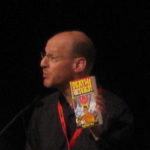Two webcomics links today: SMBC on…
Tag: Science
Mad Science: The Science Behind Science-Fiction – Fringe, Eureka! and Caprica
This was a fun panel with representatives from Eureka!, Caprica/Battlestar Galactica, and Fringe, moderated by Phil Plait of Bad Astronomy.
Some interesting moments:
After they talked about the ethics of interrogating a corpse, one of the guys from Fringe (I think Rob Chiappette) remarked that he wanted to see a Law & Order: Fringe show. I think I’d watch that!
One of the reps from Eureka revealed that they’d planned an episode that would take the Attack of the Killer Tomatoes concept and play it seriously, but it didn’t make it. Jamie Paglia said “It’s so good we didn’t do that episode.” Either Glenn Whitmann or Rob Chiappetta remarked immediately, “You’ll see it on Fringe!”
Phil Plait asked why there wasn’t more astronomy on Fringe, and Glenn Whitmann explained it was because it was a horror show, and it’s easier to creep people out with biology & neurology than astrophysics.
A fan asked the panelists whether they had ever done something dangerous on their show that made them worry about people trying the experiments at home (“Don’t try this at home, kids!”) For the most part they figured the level of technology, gadgetry and genius that their characters had made things impractical to imitate, though Rob Chiappetta added, “If you see Walter [Bishop] do something on screen, don’t do it!”
Another audience member mentioned that he worked in robotics, and was concerned about the way robots were portrayed as good or evil. If too many robots were portrayed evil, he might lose funding… Jane Espenson explained that “Killer robots are a lot more fun to watch.”
 And of course Phil Plait plugged his book, Death from the Skies! “I love having a microphone!”
And of course Phil Plait plugged his book, Death from the Skies! “I love having a microphone!”
Photos will be on my Flickr account later tonight, once they trickle through the incredibly-slow hotel wifi. Update: They’re up! The trick was apparently waiting until 6am when no one else was using the wifi.
Santa Hats, Translation, Expelled
- Saw a bunch of Santa hats lying alongside the entire length of the 55 South to 405 South ramp – and it’s a long bridge. Maybe a box came open?
- Got tech support question in Spanish for wrong company. Replied in bad Spanish with link. Checked against Google Translate. Google has a better vocabulary than I do. 🙁
- Roger Ebert dismantles Expelled (via @mikesterling).
Ben Stein Compares Scientists to Nazis
Well, what little respect I had left for Ben Stein is rapidly evaporating. Apparently it’s not good enough for him to claim that “Darwinism” leads to genocide in Expelled, now he’s running the interview circuit making statements like this:
When we just saw that man, I think it was Mr. [PZ] Myers, talking about how great scientists were, I was thinking to myself the last time any of my relatives saw scientists telling them what to do they were telling them to go to the showers to get gassed.
or this:
Love of God and compassion and empathy leads you to a very glorious place, and science leads you to killing people.
Now, let’s leave aside all of the lives saved by medicine, engineering, and other applied sciences for a moment.
And let’s ignore the fact that Stein said this on an interview with the Trinity Broadcasting Network. On television. About a movie. Both products of science. (I wonder if he ever sees doctors, or takes medication.)
And let’s table the fact that he seems to think (or finds it convenient to claim) that evolutionary biology and Social Darwinism are the same thing.
And let’s not even bring up the fact that the Holocaust was rooted in centuries of anti-Semitism, and the most scientific thing about it was the means of execution. Or that even the ADL is upset that the film “misappropriates the Holocaust,” pointing out that “Hitler did not need Darwin to devise his heinous plan to exterminate the Jewish people and Darwin and evolutionary theory cannot explain Hitler’s genocidal madness.”
And God forbid that we mention all the people killed in His name.
No, let’s not mention any of that. Let’s focus on one specific item:
In internet culture, there’s a concept called Godwin’s Law. It was an observation that, as long discussions continue over time, eventually someone will compare the other side to Nazis. A tradition has developed that once this happens, the discussion is over because no reasonable debate can be had when one side thinks the other is just plain evil. Generally, whoever makes the comparison is considered to have forfeited the argument, because they couldn’t think of anything else to support their side but stooping to the basest ad hominem attack imaginable.
At least he’s come out in the open and admitted that the movie isn’t just about suppressing the theory of evolution, but is explicitly anti-science.
Sci-Tech Links
Scientists have built a computer model of the Neanderthal vocal tract based on fossils, and have simulated the kinds of sounds they could have produced. Ever since I read Robert J. Sawyer’s Neanderthal Parallax novels, I’ve been fascinated by the idea that there were two distinct human species, living side by side, for perhaps thousands of years. What happened to them? Did our ancestors kill them off, or interbreed with them? Did they fail to adapt to a changing climate? (via Slashdot)
On a related note, it seems that Expelled, the anti-science propaganda film that actually invokes Godwin’s Law by claiming that “believing” evolution leads to Nazis, opens this weekend. I’m curious to see how badly they misrepresent things (it’s always best to look for yourself, instead of just taking other people at their word—that’s the whole idea behind science, after all), but I can’t bring myself to support them by actually giving them money. Meanwhile, Expelled Exposed is interesting reading.
In software, dria.org explains why the AwesomeBar is awesome. That’s the nickname given to the new address bar in Firefox 3, which lets you search your browser history as you type. It’s the reason I never went back to Firefox 2 after trying out one of the later FX3 betas, and why I’ve installed Fx3b5 on two more machines. The Opera 9.5 previews have a similar feature, but Firefox’s implementation is better visually. It’s easier to spot the page you want, and over time, it learns which pages you visit more often. It’s so much faster to type a word or two than to hunt through the bookmarks menu. (via Asa Dotzler)
IEEE has an article on how copyright law applies to websites, What Can You (Legally) Take From the Web?
Finally, ***Dave relates an incredibly cool story of going to see Avenue Q and what happened after the show. I had no idea that (at least in New York), the “Give Me Your Money” segment was actually collecting for a charity.
Bad Science. Good Sci-Fi.
There are certain ideas that I find completely acceptable in the context of science-fiction, but completely looney in the context of actual science.
Take, for instance, Erich von Däniken’s premise that gods were really ancient alien astronauts. It’s an interesting idea, but it’s way out there in terms of science. It assumes that (a) myths are historically accurate, (b) aliens exist, and (c) low-tech humans couldn’t possibly have created things like Stonehenge, pyramids, giant stone heads, etc. Not to say it’s not possible that aliens visited the planet in the distant past—just that comparative mythology and architecture aren’t exactly compelling evidence.
On the other hand, I have no problem with the concept in science-fiction. It’s the basic premise of Stargate. The movie and early seasons of SG-1 focused on Egyptian mythology and technology, and in subsequent seasons of the show, just about every ancient legend has turned out to have an alien race behind it. It also figures into the backstory of Babylon 5, with the Vorlons having visited nearly every known race in ancient times, insinuating themselves into local religions and engineering telepaths over the course of centuries.
(via Sclerotic Rings and *** Dave)
Gods and Comics
I was thinking about a discussion on last month’s Flash #226 and got to thinking about the way religion figures into mainstream comic books. Not the way religious characters are portrayed, but the way the fictional world works. I’m not familiar enough with Marvel (though I can make some guesses based on the presence of Thor), but DC seems to have an “anything goes” cosmology: current scientific theory coexists with the Christian God, Heaven and Hell, with gods and other supernatural beings from various mythologies—some of them made up, like the Lords of Order and Chaos—occupying their own corners of the universe.
That’s probably what you want for a long-term, open-ended shared universe, because it gives you the most opportunities for stories. Want to write about an alien race that lived billions of years ago, or evolved from cats? Check. Have a fallen angel join the Justice League? Check. Tie Wonder Woman’s origin directly to the Greek gods? Check. Use made-up alien gods to explain the Greco-Roman split? Check. Power up half your villains and a handful of heroes as they sell their souls to a devil? Check. Pit the spirit of God’s wrath against a 50,000-year-old immortal ex-caveman? Check. Send some characters to Heaven or Hell, but have others destined to be reincarnated over and over again? Check. Observe the hand of God at the moment of the big bang? Check.
There are a couple of limits. DC seems to avoid ascribing a particular religion or denomination to any of their A-list characters, probably so that readers can just assume it’s their own (kind of like setting a story in “Anytown, USA”). And they avoid direct portrayals of God or Jesus, probably for the same reason. Continue reading
